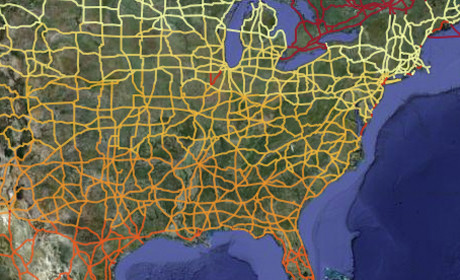
A map built using CartoDB v2
Open source software CartoDB, which enables news outlets to make map visualisations, is to launch its latest version in mid-November, with new features that aim to bring the platform "much more into the mainstream".
The cloud platform has been used by news outlets including the Guardian and the Wall Street Journal to build interactive maps.
"It allows users to visualise large amounts of data on maps, animate it temporally, run analysis and many more things," according to Javier de la Torre, chief executive at Vizzuality, the company behind CartoDB.
"Maps are one great way of visualising data, everything happens somewhere, but making them is hard, the tools are typically complicated and do not produce beautiful maps. We want to enable developers, scientists or journalists to make great maps without having to possess a masters in cartography and programming.
"Additionally, making dynamic maps, those that change continuously over time, such as live election night mapping, is hard. CartoDB makes it easy and scalable, supporting millions of visitors per day in a cost effective way."
He added that the Wall Street Journal will be using CartoDB on election night this year for example.
The tool was originally built for Vizzuality's own projects, but was then made open source.When we launched it was mainly used by scientists and developers, but then journalists started taking interest and right now probably they are our biggest user groupJavier de la Torre, Vizzuality
"When we launched it was mainly used by scientists and developers, but then journalists started taking interest and right now probably they are our biggest user group," Torre added.
Version 2.0 of the software is due to launch next month, with Vizzuality keen "to focus on bringing visualisation much more into the mainstream, meaning simplifying the tool to make it accessible to many more users".
This includes the introduction of technology which means CartoDB visualisations "can scale to be on the homepages of the biggest online newspapers without worrying about performance".
"This is a crucial step. And we have done it in a way that is effective and cheap, so we are not limiting the amount of visitors your visualisation can have and we are not charging you how many visits your maps get.
The new version also features a new design and a "lot of new user experience improvements to make things work better".
"In general we think of 2.0 as an iteration of CartoDB, to make it more robust, expandable and easier to use."
There is a currently a beta programme in progress for selected users. Those interested in joining can find out more about by contacting them through the CartoDB site.
Torre added that one of the keys of the CartoDB software is its simplicity. "Look at data formats for example, there are hundreds of different formats on the mapping world. This by itself creates a big barrier for people that want to create a map.
"We make importing these files as easy as dragging and dropping files into the CartoDB, we then take care of transformations, projections and everything that needs to be done.
"Then when making maps we provide simple tools for customising the map, and likewise have powerful languages under the hood, like SQL and CSS, letting advanced users create more sophisticated visualisations."
He added that the software is also able to "handle large datasets" and offers "a level of flexibility that is totally new in this product space".
"People can really hack around the available tools", he said giving the example of the 'political moneyball' visualisation by the Wall Street Journal. "They came up with a way of visualising hundreds of thousands of relations between donors. It is not an actual geographic map, but uses CartoDB to visualise large amounts of federal election commission data. I think it is very exciting to see innovation built on top of a product like this."
CartoDB is available open source, or there is a hosted version, which ranges from a free option for five tables and 5MB of data to paid-for accounts.
Free daily newsletter
If you like our news and feature articles, you can sign up to receive our free daily (Mon-Fri) email newsletter (mobile friendly).
Related articles
- 12 essential self-taught journalism skills
- "Your reader's trust is something money cannot buy"
- Advertorial: Improving strategic content planning in your newsroom
- James Hewes, CEO of FIPP, on the legacy of the pandemic on digital media
- Elisabeth Gamperl of Süddeutsche Zeitung on metrics anxiety in the newsroom









